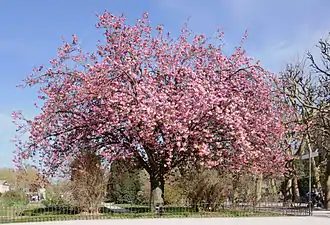Gracefulness
Gracefulness, or being graceful, is the physical characteristic of displaying "pretty agility", in the form of elegant movement, poise, or balance. The etymological root of grace is the Latin word gratia from gratus, meaning pleasing.[1] Gracefulness has been described by reference to its being aesthetically pleasing. For example, Edmund Burke wrote:
Gracefulness is an idea not very different from beauty; it consists of much the same things. Gracefulness is an idea belonging to posture and motion. In both these, to be graceful, it is requisite that there be no appearance of difficulty; there is required a small inflection of the body; and a composure of the parts in such a manner, as not to encumber each other, not to appear divided by sharp and sudden angles. In this ease, this roundness, this delicacy of attitude and motion, it is that all the magic of grace consists, and what is called its je ne sais quoi; as will be obvious to any observer, who considers attentively the Venus de Medicis, the Antinous, or any statue generally allowed to be graceful in an high degree.[2]
.jpg.webp)


The difficulty in defining exactly what constitutes gracefulness is described in this analysis of Henri Bergson's use of the term:
The organic form of drama is most clearly suggested in Bergson's use of the word 'gracefulness' [la grâce]. Gracefulness is not imposed from without but generated from within. Gracefulness is 'the immateriality which ... passes into matter.' In this formulation, the soul, or what Bergson elsewhere calls the élan vital, the life force, shapes the matter that contains it. The soul is not immobilized by matter, as it is in comedy, but remains infinitely supple and perpetually in motion.[3]
Gracefulness is often referenced by simile, with people often being described as being "as graceful as a swan",[4][5][6] or "as graceful as a ballerina".[7][8] The concept of gracefulness is applied both to movement, and to inanimate objects. For example, certain trees are commonly referred to as being "graceful", such as the Betula albosinensis, Prunus × yedoensis (Yoshino cherry), and Areca catechu (betel-nut palm).[9][10][11]
Gracefulness is sometimes confused with gracility, or slenderness, although the latter word is derived from a different root, the Latin adjective gracilis (masculine or feminine), or gracile (neuter)[12] which in either form means slender, and when transferred for example to discourse, takes the sense of "without ornament", "simple", or various similar connotations.[13] The Shorter Oxford English Dictionary remarks of gracility, for example: Recently misused (through association with grace) for Gracefully slender. This misuse is unfortunate at least, because the terms gracile and grace are completely unrelated: the etymological root of grace is the Latin word gratia from gratus, meaning pleasing[14] and nothing to do with slenderness or thinness.[14]
References
- Little, William; Fowler H.W.; Coulson J.; Onions, C.T. (Ed.): "Shorter Oxford English Dictionary on Historical Principals". Pub.: Oxford at the Clarendon Press (1968)
- Edmund Burke, A Philosophical Enquiry into the Origin of Our Ideas of the Sublime and Beautiful (1756), p. 226-227.
- Alan Louis Ackerman, Seeing Things: From Shakespeare to Pixar (2011), p. 55.
- Robert Allen Palmatier, Speaking of Animals: A Dictionary of Animal Metaphors (1995), p. 174.
- John E. Ray, A Trip Abroad: Sketches of Men and Manners, People and Places, in Europe (1882), p. 107: "There are two thousand of them constantly gliding back and forth through the canals, as noiseless as a ghost and as graceful as a swan".
- Edwin Russell Jackman, John Scharff, Steens Mountain in Oregon's High Desert Country (1967), p. 70: "'Graceful as a swan' is almost a cliche, it has been used so often".
- Susan K. Cahn, Coming on Strong: Gender and Sexuality in Twentieth-century Women's Sport (1995), p. 219, quoting a Life magazine photo-essay on gymnasts as saying that "a gymnast can be as graceful as a ballerina and as appealing as a model in a perfume ad".
- Arnold L. Haskell, The Wonderful World of Dance (1960), p. 76: "Dancing as education, understood by the Greeks, today is coming to the fore again. With limbs less supple, but more powerful than a woman's, a male dancer's virile leaps are every bit as graceful as a ballerina's".
- John Freeman, Create Your Own Woodland Garden (2010), p. 45: "B. albo-sinensis: Chinese Birch, ultimately makes a 15 metre (50ft) graceful tree with glossy green leaves turning golden yellow in the autumn.
- Carol W. Hall, Norman E. Hall, The Timber Press Guide to Gardening in the Pacific Northwest (2009), p. 129: Prunus × yedoensis (Yoshino cherry). Very graceful tree blooms early, with medium-sized, lightly fragrant flowers of pale pink appearing before leaves.
- Sophy Moody, The Palm Tree (1864), p. 88-89, on the betel-nut palm: "At three years old it begins to bear long bunches of orange-coloured fruit, which, contrasting with the deep rich hue of the leaves, adds the charm of colour to that of gracefulness of form".
- Gray, Mason D., Jenkins, Thornton; “Latin for Today, Book 2”; Pub: Ginn and Co., Ltd. (1934)
- Simpson, D. G. (1977). Cassell's Latin dictionary: Latin-English, English-Latin. London: Cassell. ISBN 0-02-522580-4.
- Little, William; Fowler H.W.; Coulson J.; Onions, C.T. (Ed.): "Shorter Oxford English Dictionary on Historical Principals". Pub.: Oxford at the Clarendon Press (1968).